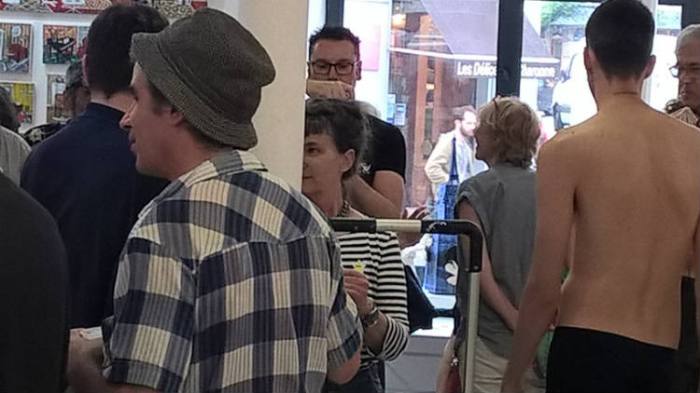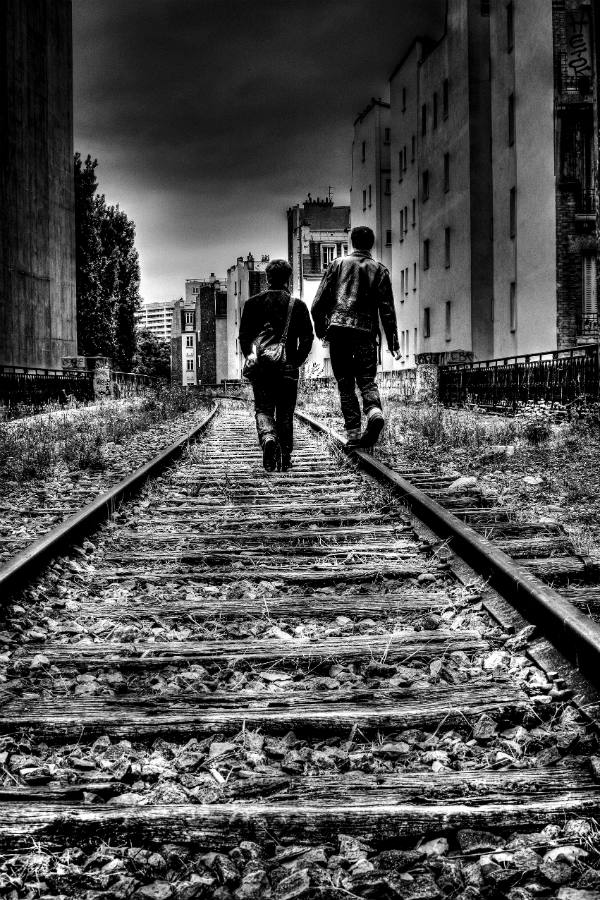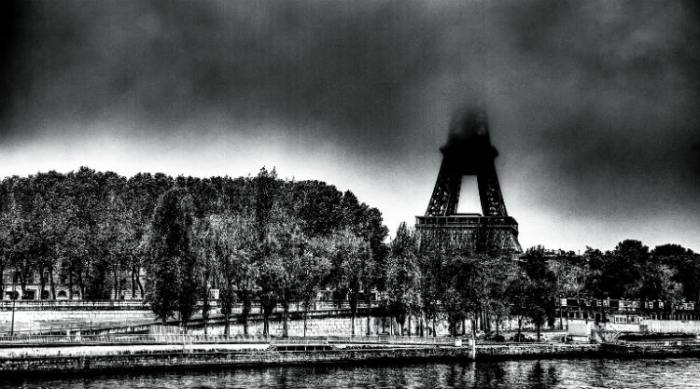
Alanig Keltz,”Passerelle Debilly.” Image copyright and courtesy Alanig Keltz. See more of the artist’s work on his website.
PARIS — So there I was all set to argue that the only truly transgressive visual artists are those who make graffiti, because except when commissioned, they risk a fine (amende) every time they put chalk to wall or shake up an aerosol color can. Then I decided to take my Brourcq — tea break on the banks of the Ourcq canal — only to find two men in gas masks fervently attacking a metal industrial hut with their spray-cans, the fumes respirable by everyone downwind of them (and who unlike them did not have the benefit of protective masks). These two ‘artists’ were basically flipping the finger at us common people (not to mention the environment); what mattered was their right to spray and mark their territory.

Jordane Saget, Untitled. Image copyright Jordane Saget and courtesy Artists Ateliers of Belleville.
By contrast, Jordane Saget — one of the artists I’d encountered at the June 23 opening for the collaborative Brazilian – Bellevilloise Street Art exhibition running through July 10 at the gallery of the Artists Ateliers of Belleville at 1 rue Francis Picabia — seemed much more considerate of the public weal. First, Saget works primarily in chalk. Second, he candidly admitted that while this medium is erasable on sidewalks, it’s a bit more complicated to remove from walls. And then there’s the level of his art, which is as rigorous as it is simple. During the opening, while another group of artists was spray-painting a wall bordering the gallery and a third man was flaunting his barely-garbed stuff in high-heels, Saget, dressed in blue jeans and a tee-shirt, was humbly drawing on the sidewalk with a petite stub of white chalk.
 Annie Barel (center) prepares a canvas while model Fernando Audmouc (right) primes for their collaboration and a blasé critic (left) contemplates the buffet table. See some of Barel’s published work here.
Annie Barel (center) prepares a canvas while model Fernando Audmouc (right) primes for their collaboration and a blasé critic (left) contemplates the buffet table. See some of Barel’s published work here.
The high-heeled gangly drag queen/ performing/graffiti artist, Nina el Polin, who leaves his misspelled mark, “Nina Was Her” on and in buildings and above bath-tubs throughout Paris, seemed to have followed me to the next evening’s opening, of the group exhibition Petites Oeuvres Parisiennes at the collective gallery Le Genie de la Bastille, but it was in fact just a doppelganger, Fernando Audmouc, there to strip to his shorts and hang himself from a rafter so that Annie Barel could apply strips of black duct tape to his elongated tummy while an ’80s nouvelle vague version of “La Vie en Rose” played. Before this moment, I’d encountered, albeit second-hand, an artisan who has quietly been working at his oeuvre for 70 years:
“I was promenading on the rue Parmentier,” another artist recounted to me and photographer-filmmaker Alanig Keltz — as we stood before Keltz’s stark black and white photographs of a fog-shrouded Eiffel tower, a suburban suspended bridge or passerelle over the Seine, and a couple of teenagers walking down an overground railroad track that’s part of the abandoned, overgrown “Petite Ceinture” around Paris — “when I came across a window display full of broken dolls. When I started to photograph this, a wrinkled old man emerged from the store and explained that during the Occupation, he was walking down a road with his young daughter, fleeing Paris, when a German tank rolled over his little girl. The tank driver then backed up over her. Since then, the man has made his living repairing broken dolls.”

Alanig Keltz,”Errance.” (Taken along the Petite Ceinture in Paris.) Image copyright and courtesy Alanig Keltz. See more of the artist’s work on his website.
This reminded me of the experience recounted by Pierre, an eighty-something neighbor in the Dordogne, which I then shared with the two artists. At the end of the war, a German regiment was on its way to back up besieged colleagues in La Rochelle. Their intention was to by-pass our village, but a group of young maquisards had other plans, ‘going to the encounter” of the SS troops. Hunkering down, the Germans started firing at everything and everyone in site. Pierre’s 14-year-old brother — he was 12 — wanted to show him a bird’s nest another brother had made in the woods. They’d not gone 100 yards when a bullet struck down his brother, and another whizzed by Pierre’s ear. “The bullet that killed my brother was fired from one kilometer away.” It may have been mortal, but it was impersonal. “That’s horrible,” said one of the artists after I’d finished. “Horrible yes,” I said, “but I think there’s also beauty there: That in the midst of a war, beholding a bit of wonder, a bird’s nest, was still important to these boys.”

Alanig Keltz,”ParisBrûmetil?” Image copyright and courtesy Alanig Keltz. See more of the artist’s work on his website.
I think we’re living a similar moment right now in France, at its most morose (on a societal level; it’s not like you encounter frowns everywhere you go) in the 15 years I’ve been spending time here. (Although it should be added that the ambiance in Paris is more morose than in the countryside.) On top of the usual reasons — labor and political strife — there are the lingering shadows of the 13 November massacres, the obsession with Muslims and Islam that followed them, and the epuissement of over-worked police. Police who have been understandably upset at a much more objectionable — and local government-sponsored — piece of graffiti which recently went up on public property in Grenoble, showing police beating “Marianne,” the national symbol, with clubs. The usual freedom of speech defense was trotted out by the Left-leaning municipal government, but do a few cases of police over-reaction really justify denigrating all of these men and women at a time when they’re working over-time without relief and bearing the brunt of the security burden? (And unlike just about everyone else, they’ve only held one demonstration… during which hoodlums burned one of their vehicles.)
The cure, obviously, is not to attack the defenders, however imperfect they may be, but to find the bright, even humorous points even in dark times. Pierre Millotte, another artist featured in the Petites Oeuvres Parisiennes, provided a portal of light here. In one of a series of miniature book-lets, he relates the Adventures in Roommates of “Claude C” in the New York of the late ’80s as well as Paris. One of the tales Millotte recounts is of a psychotic far West Village roommate who, after telling him that Catherine Deneuve and Jean-Louis Tritignant have been killed in a tragic road accident, steals his ticket home. After “Claude C” has moved out, the ticket mysteriously shows up in an envelope addressed to him at the Washington Square Hotel, where he works. There are obviously two ways to see this story.
Which is yours? — Paul Ben-Itzak

Life Goes on: Sylvie Lesgourgues, “Café Belleville, ‘Follies.'” Image copyright and courtesy Sylvie Lesgourgues. I met Sylvie Lesgourgues on November 12, 2015, during an opening for a group exhibition in a gallery not far from the Bataclan concert hall which would become a killing field 24 hours later. Lesgourgues impressed me immediately as a politically engaged but also aesthetically meritorious artist, particularly with a panel of postage stamps featuring the visages of migrants — as if it would be so much easier if they could just mail themselves to their safe havens. When we re-connected recently, she told me that she was now also interested in simply conveying that life goes on, that we still go out and gather together here in Paris. This painting is part of the group expo Petites Oeuvres Parisiennes, discussed above, and which runs through July 3 at Le Genie de la Bastille. To see more work by Sylvie Lesgourgues, visit her website. — PB-I
